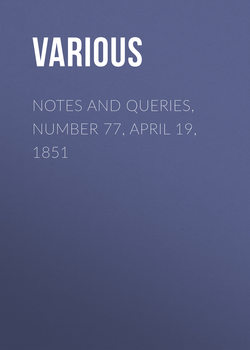Читать книгу Notes and Queries, Number 77, April 19, 1851 - Various - Страница 4
Notes
BISHOP THORNBOROUGH'S MONUMENT
Оглавление[The writer of the following interesting communication does not appear to be aware that he is obliging us and a correspondent D. Y., who had asked (Vol. iii., p. 168.) for an explanation of the phrase Denarius Philosophorum, in the Bishop's Monument.]
Our local antiquaries have long been puzzled by an inscription in the Lady chapel of our cathedral. It stands on the monument of Bishop Thornborough, and was prepared by himself fourteen years before his decease in 1641, at the age of ninety-four. He was addicted to alchymy, and published a book in 1621, entitled Λιθοθεωρικος, sive, Nihil aliquid, omnia, &c. In the course of some recent studies in the Pythagorean philosophy, my attention was accidentally engaged by this inscription; and it at once struck me that it was thence that the explanation was to be derived. The epitaph is as follows: on one side,
"Denarius Philosophorum, Dum Spiro, Spero."
on the other,
"In Uno, 2o. 3o. 4or 10. non Spirans Sperabo."
The latter letters are now effaced.
It is well known that the Pythagoreans found all the modes of space in the relations of numbers.
The monad, or unit, was not only the point whence all extension proceeds, but it further symbolised the First Principle, the origin of all. The duad represented the line, as being bounded by two points or monads. The triad stood for surface as length and width. The tetrad for the perfect figure, the cube, length, depth, and width. The decad, or denarius, indicated comprehensively all being, material and immaterial, in the utmost perfection: hence the term decas, or denarius, was used summarily for the whole science of numbers, as in the title of Meursius's tract De Denario Pythagorico, which was published four years after the date of the inscription, and when the philosophy was attracting much attention among European scholars. To be as concise as possible then, I presume that the old bishop intended that the tomb on which his effigy lies was his access to that perfection of existence which philosophers had designated by the decas, or denarius. During the present life he was hoping for it, "Dum Spiro, Spero."—On the other side: "In Him, who is the source, the beginning, the middle, and the end of all existence and perfection (in Uno, 2o. 3o. 4or 10. non Spirans Sperabo), though I breathe no more, yet shall I hope."
Such is probably the meaning of his pious conceit, and I offer it as a solution of what has long served for a riddle to the visitors of our cathedral. Beyond this, your readers and myself may be equally indifferent to such cabalistical quaintness. But let us treat it with charity, as the devout consummation of an aged alchymist.
O. F.
College Green, Worcester, March, 1851.
